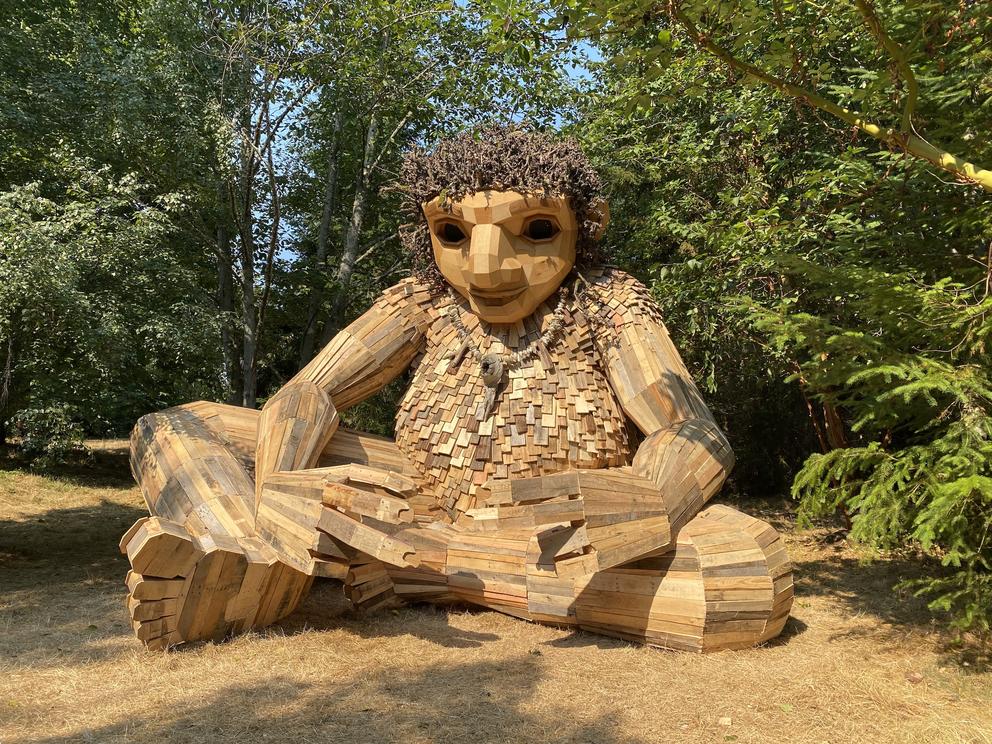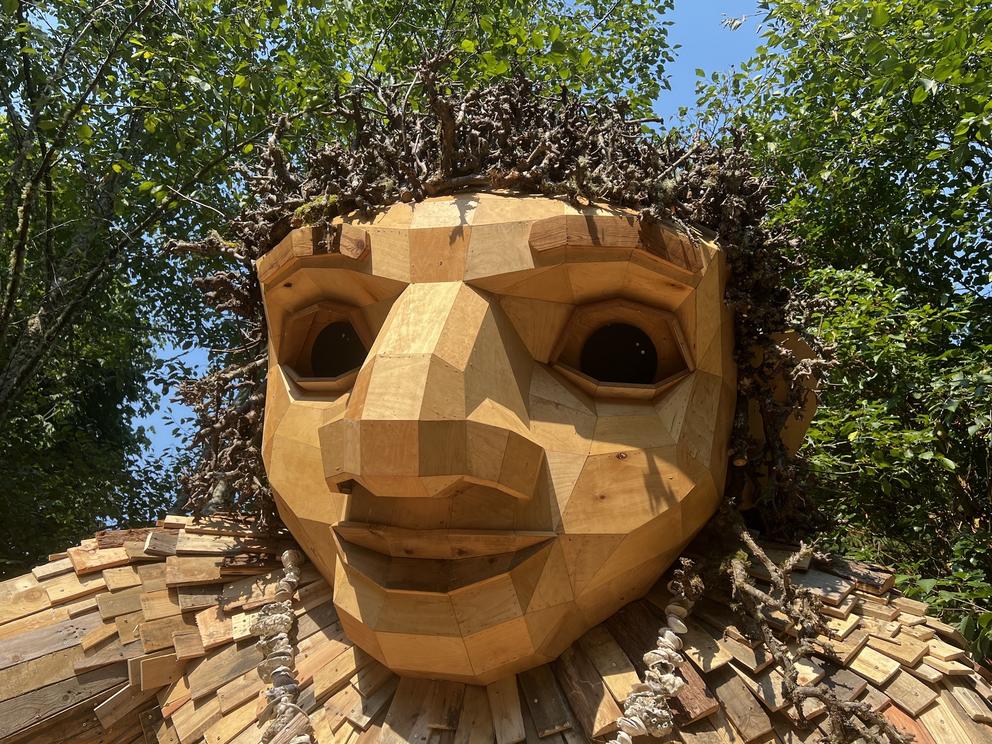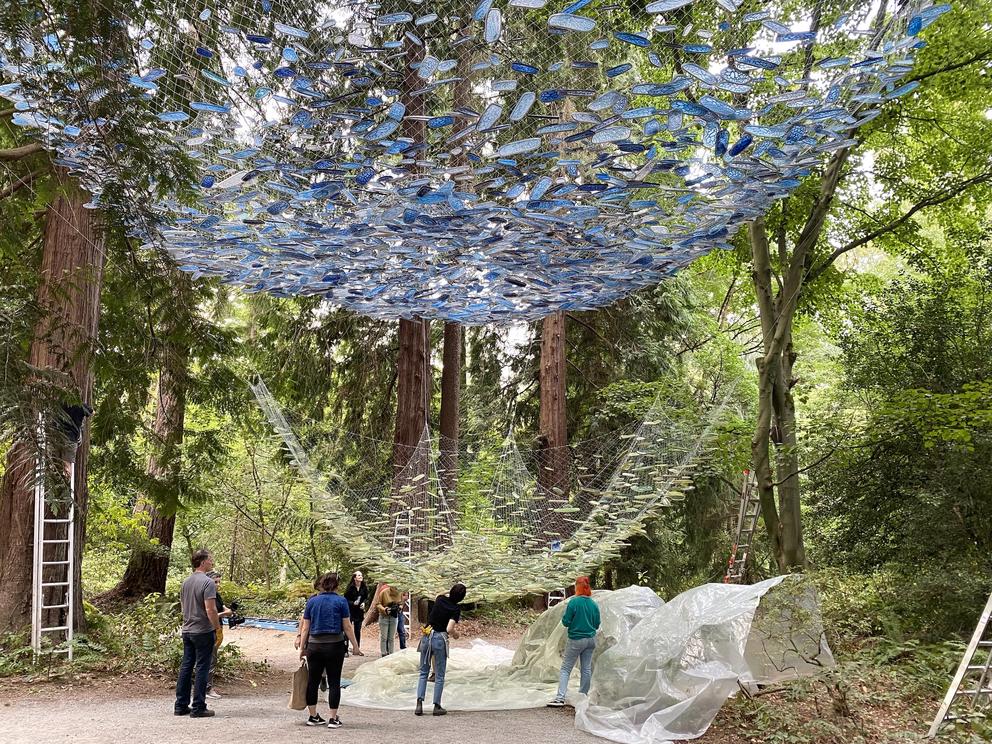Pia the Peacekeeper sprouted up in a small grove on Bainbridge Island last weekend. Sitting in Sakai Park at 16 feet tall, this troll is crafted almost entirely of scrap and found wood — including 160 donated wooden pallets, which volunteers deconstructed and reconstructed into long “snakes” nailed together end to end.
As Bainbridge Island Park Commissioner Dawn Janow told me winkingly during my visit, “She’s probably 28 feet tall when standing up.”
Pia’s head (crafted outside Copenhagen and shipped to Seattle) is boldly geometric, almost cubist. Her somewhat scraggly hair is made from donated apple-tree branches from Poulsbo and moss gathered from nearby Strawberry Hill Park.
Her seashell and driftwood necklace? Also sourced locally. Her carved toenails are magnificent and her black eyes twinkle with mischief, thanks to a couple artfully placed screws that catch the light.
The troll is here courtesy of Danish environmental artist Thomas Dambo (whose name you may recall from the Nordic Swan he made from recycled buckets and positioned outside the National Nordic Museum last year).
Since 2014, Dambo has been sharing his message of recycling in the form of eye-grabbing, handcrafted trolls — each one distinct and site-specific — installed around the world (consult the troll map). Pia is Dambo’s 121st troll.
Over the next month, the artist will build six trolls in the Northwest, including one just completed in Portland. With his deep respect for cultural lore from Scandinavia and all over, Dambo has worked with Muckleshoot and Snoqualmie tribal leaders here to incorporate local Indigenous traditions into the process.
When Dambo’s “Way of the Bird King” tour of the Pacific Northwest (supported by the Scan Design Foundation, the Paul G. Allen Family Foundation and Visit Seattle) is complete, Washington will have trolls in five locations, including West Seattle (to be revealed this weekend, Aug. 25), Issaquah, Vashon Island and Ballard.
ArtSEA: Notes on Northwest Culture is Crosscut’s weekly arts & culture newsletter.
Like the Fremont Troll (apparently no relation), Dambo’s creatures are compelling in their oversized scale, their humanoid features and the way their folklore barges in on real life. And despite their inherent whimsy, trolls often have a whiff of danger.
While the Fremont Troll famously crushes a real VW Beetle in its grip, the new Portland troll peeks into a house and ponders putting the human occupants “in his belly.” Even Pia the Peacekeeper comes with a warning: “Quiet little people, ’cause your criers make me tired,” chides her accompanying poem.
As Janow explained it: “The story goes that Pia welcomes people to play inside her hands but you have to play nicely, or else, woop!” Here she threw her arm up and back, as if tossing a bad apple over her shoulder.
The trolls will stick around for at least three years, if we behave.
Late summer is bringing more surprises to local parks …
At the Washington Park Arboretum, a shady copse has been set ashimmering with a new art installation by John Grade. The locally based environmental artist is perhaps best known here for his giant wooden tree sculptures, which hang in the lobby of the Seattle Art Museum and at the N Gates at Sea-Tac Airport.
But for this project, his goal is not so much recreating a tree’s exoskeleton as its remarkable inner workings.
Called Union, the new sculpture consists of two giant nets in which are caught 6,500 molded resin pieces resembling the cell structure of Western red cedars. The pattern on each individual piece looks a bit like a turtle shell, but instead of being opaque, each rounded rectangle — in 27 different sizes — is translucent, lightly pigmented in sky blue and grass green.
One net contains all the blue pieces, the other all the greens; both are suspended high inside a circle of eight tall cedars. Seen from underneath, they disappear and reappear against the surrounding green leaves and blue sky. When sunlight hits the resin, the dappled effect causes onlookers to utter an instant “Ohhh.”
When I arrived for the installation, Grade’s studio employees were standing high on ladders propped against the trees, adjusting the stainless steel wires that suspend Union over a pathway. As installers pulled the wires tree by tree in a “round the clock” pattern to hoist the net higher, it looked like a stained-glass circus tent rising in the forest.
“There are so many different sightlines here,” Grade told me, standing on the wooded path. “I like the idea of people just coming upon it on a walk.” Arboretum staff assured me that directional signage is forthcoming, but you can find the piece just west of the Fiddleheads outdoor preschool area. (Look up.)
Grade told me that the nets represent two cross-sections of a cedar’s “dendrochronology,” the growth rings that expand and multiply with the years. But instead of rings, we’re seeing the cells, as if magnified.
All his artworks have a strong ecological element. Here, the green pieces are slightly concave, angled to catch and release water — and in that way “take the temperature of the environment,” Grade explained.
The green net will bow lower after heavy rains. The blue pieces are convex; on these, the recent rain was evident in droplets still sitting on the resin, adding more refractions to the forms.
The official Union opening takes place this fall (Sept. 24, 10 a.m. - 1 p.m.; free) and will include docent-led tours and tram tours. The installation is expected to stay up for about five years, with regular maintenance. Grade said he’s eager to experience it during the seasons — to hear the resin pieces tinkling against each other in a stiff wind, to see them holding remnants of snowfall.
And what if birds decide the nets make for great nests? “Oh,” Grade said, “I would love that.”
Get the latest in local arts and culture
This weekly newsletter brings arts news and cultural events straight to your inbox.






